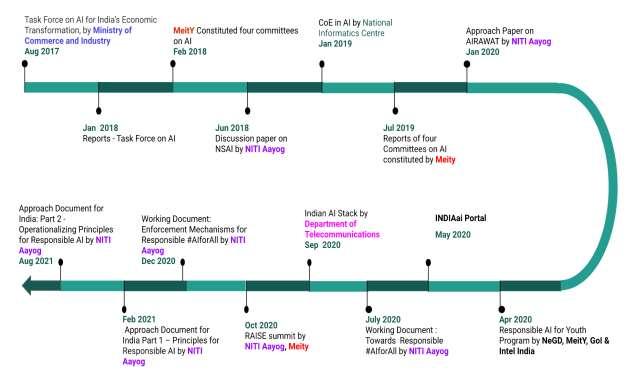
56 minute read
Chapter 1 Background
CHAPTER 1
BACKGROUND
Advertisement
1.1. Emerging Importance of Artificial Intelligence (AI) and Big Data (BD)
1.1.1. Artificial Intelligence (AI) and Big Data (BD) are the emerging technologies that are rapidly transforming today’s world. Remarkable surge in AI capabilities have led to many innovations including autonomous vehicles, wearables to track health conditions, virtual assistants and face recognition systems. AI is contributing in development and revolutionization of each and every sector. As per report published by McKinsey & Company1 AI has already been adopted in various industries such as High Tech Automotive and Assembly Lines, Telecom, Travel, Transport and Logistics, Consumer Packaged Goods, Retail, Electric Power and Natural Gas, Healthcare Systems and Services, Financial Services, Professional Services, Infrastructure Services and many more.
1.1.2. Like various other sectors, telecom sector is also undergoing digital transformation through adoption of AI and BD. These technologies have been deployed in telecom network for network operations, customer service provisioning, delivery management, and infrastructure operations of telecom companies. The adoption of AI and BD in telecom sector has improved network reliability and customer experience, optimized cost of operations, generated new revenue and taken strategic business decisions and much more. The information published on website, Guavus2 states that AI with advanced analytics has saved 100 million USD in network Capital Expenditure (CAPEX) in first year. It further indicated that AI with advance analytics has reduced Mean time to repair (MTTR) and poor Quality of Experience (QoE) by 50% for Voice over LongTerm Evolution (VoLTE) subscribers, and also predicted 40% hardware
1 https://www.mckinsey.com/~/media/McKinsey/Featured%20Insights/Artificial%20Intelligence/Global%20AI %20Survey%20AI%20proves%20its%20worth%20but%20few%20scale%20impact/Global-AI-Survey-AI-provesits-worth-but-few-scale-impact.pdf 2 https://www.guavus.com/
failures prior to customer impact and reduced data storage by 90%. In future, these technologies would be a game-changer for achieving scalability and security demanded by 5G and the Internet of Things (IoT).
1.1.3. The pace of AI development has not been found consistent over the years since its inception sixty years ago3. The recent keen interest in AI may be attributed to technological advancements in internet, computation power, a number of data generating devices supported by the advent of technologies such as cloud computing and edge computing.
1.1.4. All these developments are further supported by advanced data analytics technologies and tools provided by BD which helps professionals to collect, process, clean and analyse growing volume of data. Common technologies and tools used to enable big data analytics processes include Hadoop, Spark, Predictive Analytics, Stream Analytics, Distributed Storage, and Data Virtualisation etc. Thus, with Big Data Analytics, AI can drive more value from the network data to train and test its models to initiate actions and decisions in the network. BD is a
key element of AI. The Chapter 2 covers these aspects in detail.
1.1.5. The market for AI is already large and growing rapidly. In Feb 2021, the International Data Corporation (IDC)4 predicted that by 2024, the market of AI is expected to break the $500 billion mark with a five-year Compound Annual Growth Rate (CAGR) of 17.5% and total revenues reaching an impressive $554.3 billion. Additionally, investment in AI and Machine Learning (ML) companies has increased dramatically. The Indian AI and analytics start-ups received $1,108 million in funding in 20215, the highest ever funding in seven years, with a year-over-year growth rate of 32.5%.
1.2. AI Policy Landscape
1.2.1. Though the benefits of AI are significant, it may sometimes have serious
3 https://sitn.hms.harvard.edu/flash/2017/history-artificial-intelligence/ 4 https://www.idc.com/getdoc.jsp?containerId=prUS47482321 5 https://analyticsindiamag.com/study-indian-ai-startup-funding-in-2021/
consequences such as privacy violations, discrimination and biased results. Probable risks from AI are attracting the attention of the regulators to examine and consider adequate measures to mitigate the same without losing the potential benefits. The probable risks are discussed in the later chapters. The section below highlights the strategies and initiatives taken by various countries to harness the potential of AI technologies, as well as address the associated risks.
1.2.2. National Strategies in other jurisdictions (Countries)
i. In the past few years, countries around the world have taken several initiatives to frame strategies to guide and foster the development of AI and mitigate the risks associated with it. The
Artificial Intelligence Index Report 20216, published by Stanford
University has highlighted the initiatives taken by various countries in this regard. As per above report, countries like
Canada, China, Japan, Finland, United Arab Emirates, began to formulate national and regional strategies in 2017. Thereafter, in 2018, many countries such as France, Germany, United Kingdom and European Union also has published their plans and strategies regarding adoption of AI and related subjects. As of now, many countries have prepared their strategic plans for the adoption of AI, and some are at the public consultation stage, as mentioned in table 1.1.
ii. Countries are focusing on key areas such as education, health, economy, transport etc. and are majorly focussing on subjects such as research and development, skilling and reskilling, development of standards, developing AI-related infrastructure, data hubs and ethics. Some of these initiatives will be discussed in
detail in the following chapters.
iii. As per the information published on the websites and in the reports, most of the countries are working on the adoption of AI
6 https://aiindex.stanford.edu/wp-content/uploads/2021/03/2021-AI-Index-Report_Master.pdf
from a national perspective. It is also worth noting that the responsibility to oversee AI development has either been given to existing ministries like education, health, communication, etc, or a new entity has been created particularly for this purpose. In countries like Canada, France, Germany, and others mentioned in table 1.1, existing ministries are part of strategic planning for AI initiatives. Whereas, in countries like the United Kingdom, Japan, Singapore, and Saudi Arabia, a separate entity such as an office/council/ department/authority, has been established for AI development.
Table 1.1: List of countries with AI strategies
Country Name AI Strategy Responsible Organisation
Australia Artificial Intelligence Roadmap / An AI Action Plan for all Australians
Brazil Brazilian Artificial Intelligence Strategy
Canada Pan Canadian AI Strategy
European Union Coordinated Plan on Artificial Intelligence ● Commonwealth Scientific and Industrial
Research Organisation (CSIRO), ● Data 61, and ● the Australian government
Ministry of Science, Technology and Innovation (MCTI)
Canadian Institute for Advanced Research (CIFAR)
European Commission
France AI for Humanity: French Strategy for Artificial Intelligence ● Ministry for Higher Education, Research and
Innovation; ● Ministry of Economy and Finance; ● Directorate General for Enterprises; ● Public Health Ministry; ● Ministry of the Armed Forces; ● National Research Institute for Digital Sciences;
Inter-ministerial Director of the Digital
Technology and the Information and
Communication System
Germany AI Made in Germany ● Federal Ministry of Education and Research; ● Federal Ministry for Economic Affairs and Energy; ● Federal Ministry of Labour and Social Affairs
Indonesia National Strategy for the Development of Artificial Intelligence (StranasKA)
Japan Artificial Intelligence Technology Strategy
Russia National Strategy for the Development of Artificial Intelligence
Saudi Arabia National Strategy on Data and AI (NSDAI)
Singapore National Artificial Intelligence Strategy ● Ministry of Research and Technology (Menristek), ● National Research and Innovation Agency (BRIN), ● Agency for the Assessment and Application of
Technology (BPPT)
Strategic Council for AI Technology
● Ministry of Digital Development,
Communications and Mass Media; ● Government of the Russian Federation
Saudi Data and Artificial Intelligence Authority (SDAIA)
Smart Nation and Digital Government Office (SNDGO)
South Korea National Strategy for Artificial Intelligence Ministry of Science, ICT and Future Planning (MSIP)
UK Industrial Strategy: Artificial Intelligence Sector Deal Office for Artificial Intelligence (OAI)
US American AI Initiative The White House
1.2.3. National strategies and initiatives being taken in India
India is catching up with the leading countries to harness the potentials of AI, BD. Many government projects and initiatives7 at state and central level were undertaken in this direction, which got further push from NITI Aayog. A national strategy document on AI was published in 2018 by NITI Aayog. Ministries such as the Ministry of Commerce and Industry, Ministry of Electronics and Information Technology (MeitY), Department of Telecommunications (DoT) under Ministry of Communications, NITI Aayog under Ministry of Planning and many other departments in the Government have taken initiatives and are contributing towards the growth of AI in India. These initiatives cover
7 https://indiaai.gov.in/initiatives
aspects such as providing data for AI training, creating architecture for high computing infrastructure, boosting research and development, skilling-reskilling workforce, building centres for excellence, spreading awareness, and identifying principles and their implementation strategies for developing responsible AI system in the country. A brief description of all such initiatives taken by various ministries is listed in Annexure II. The timelines for the initiatives mentioned in the
Annexure II is given below in figure 1.1:
Figure1.1: Initiatives taken by NITI Aayog and MeitY for Proliferation of AI in India
1.2.4. Initiatives by International Regulators
Telecom sector regulators such as Infocomm Media Development Authority (IMDA) Singapore, Federal Communications Commission (FCC) of USA have taken further steps for leveraging AI technologies in their sectors. IMDA was an active partner in the national programme to catalyse, synergise and boost Singapore’s AI capabilities. Also, in June
2019, IMDA released the Trusted Data Sharing Framework8 to help
8 https://www.imda.gov.sg/infocomm-media-landscape/SGDigital/tech-pillars/Artificial-Intelligence
companies overcome challenges in addressing trust deficit between data providers and develop trusted data. Further, in May 20229, IMDA/PDPC launched A.I. Verify which is an AI Governance Testing Framework and Toolkit to demonstrate Responsible AI in an objective and verifiable manner. The FCC took cognizance of the impact of AI on the nation’s
network and formed a working group on AI (AIWG) to study the impact of AI in the telecom sector. The working group gave recommendations10 on creation of a task force to address aspects of data governance. It also suggested that FCC should establish policies and approaches to ensure the safe use of AI.
1.2.5. Initiatives taken by International Telecommunications Union (ITU)
ITU has been actively involved in the quest for new technological solutions to address the issues on various aspects such as the technological needs of the future networks, natural disaster management, AI for Digital Agriculture and AI for health etc. The ITU created focus groups under study groups to augment the study group work programme by providing an alternative working environment for the quick development of specifications in their chosen areas. The task of these focus groups is to investigate and jump-start new directions in ITU-T standardization. A number of such focus groups are actively working on various subjects such as:
i. Focus Group on Machine Learning (ML) for Future Networks
including 5G (FG ML5G)11: It was created by ITU-T Study Group 13 at its meeting in Geneva, 6-17 November 2017. The Focus
Group drafted ten technical specifications for ML for future networks, including interfaces, network architectures, protocols, algorithms and data formats. FG ML5G was active from January 2018 until July 2020.
ii. Focus Group on AI and IoT for Digital Agriculture (FG-
9 https://www.imda.gov.sg/infocomm-media-landscape/SGDigital/tech-pillars/Artificial-Intelligence 10 https://www.fcc.gov/sites/default/files/fcc_aiwg_2020_whitepaper_final.pdf 11 https://www.itu.int/en/ITU-T/focusgroups/ml5g/Pages/default.aspx
AI4A)12: It was created to improve the management of agricultural production processes and achieve food security.
iii. Focus Group on Technologies for Network 2030 (FG NET-
2030)13: It was created to study the capabilities of networks for the year 2030 and beyond.
iv. Focus Group on AI for Natural Disaster Management (FG-
AI4NDM)14: It was created to explore the potential of AI in supporting data collection and handling, improving modelling, extracting complex patterns and gaining insights from a growing stream of geospatial data to enhance the preparedness for (and response to) natural disasters.
v. ITU-T Focus Group on AI for autonomous and assisted driving
(FG-AI4AD)15: It was created to support standardisation activities of AI evaluation in autonomous and assisted driving.
vi. ITU-T Focus Group on “Environmental Efficiency for Artificial
Intelligence and other Emerging Technologies” (FG-AI4EE)16:
It was created to identify the standardization gaps related to the environmental performance of AI and other emerging technologies including automation, augmented reality, virtual reality, extended reality, smart manufacturing, industry 5.0, cloud or edge computing, nanotechnology and 5G among others.
1.2.6. AI Policy Landscape in Telecom Sector
i. Apart from the national strategies and general policies on AI, sector specific regulatory requirements are being worked out to address the challenges associated in adoption of AI. Sector specific requirements are also aligned in line with policies and strategies on AI at national level.
12 https://www.itu.int/en/ITU-T/focusgroups/ai4a/Pages/default.aspx 13 https://www.itu.int/en/ITU-T/focusgroups/net2030/Pages/default.aspx 14 https://www.itu.int/en/ITU-T/focusgroups/ai4ndm/Pages/default.aspx 15 https://www.itu.int/en/ITU-T/focusgroups/ai4ad/Pages/default.aspx 16 https://www.itu.int/en/ITU-T/focusgroups/ai4ee/Pages/default.aspx
ii. In India, the National Digital Communications Policy17 (NDCP), 2018 seeks unlocking of the transformative power of digital communications networks for achieving the goal of digital empowerment and improved well-being of the people of India. The efforts are being made to outline a set of goals, initiatives, strategies and intended policy outcomes. NDCP further, motivates towards harnessing the power of emerging digital technologies, including 5G, AI, Internet of Things (IoT), cloud and BD to catalyse the fourth industrial revolution. Thus, in order to create a roadmap for AI, emerging technology and its use in the communication sector, vide letter [Refer Annexure I] dated 6th June 2019, Department of
Telecommunication (DoT) sought recommendation of TRAI on the provision no. 2.2(g) of NDCP-2018 i.e. “Leveraging Artificial
Intelligence and Big Data in a synchronised and effective manner to enhance the overall quality of service, spectrum management, network security and reliability”.
1.3. Scope of Consultation Paper
1.3.1. The aspects of AI and BD referred by the DoT for seeking recommendations from TRAI mainly focusses on the telecom sector. However, there are many other sectors where telecom and Information and Communications Technology (ICT) sector can play an important role in building AI based capacity and capabilities. To understand such capabilities, a virtual conference on “Leveraging Artificial Intelligence (AI), Machine Learning (ML), and Big Data in the Telecom Sector” was organised by the TRAI on 5th and 6th of August 2020. Conference provided an opportunity to interact with the industry experts, telecom service providers and leading solution providers to understand AI and BD from telecom’s perspective, learn about use cases of AI and BD in telecom sector and global view of network insights with AI and BD. It was also presented how future networks shall incorporate AI at various levels to make telecom networks as a cross-sectoral hub for flow of
17 https://dot.gov.in/sites/default/files/Final%20NDCP-2018_0.pdf
information. The next generation telecom network would offer services far beyond connectivity which include computational power, storage, and role in developing and running AI models. For leveraging AI and BD in the telecom sector and its support to other sectors for exploiting features of AI and BD, a re-look is required on existing provisions of the licenses and regulations in telecom sector. Further, it is required to explore new possibilities that might be useful for promotions and expansions of AI based systems in the respective sectors.
1.3.2. Accordingly, the scope of the consultation paper is to seek comments from stakeholders on the aspects referred to by the DoT and also to seek comments on various other aspects where the telecom sector can play an important role to leverage AI and BD in other sectors.
1.4. Structure of Consultation Paper
This consultation paper is composed of six chapters. Chapter 2 deliberates on the concepts of Artificial Intelligence (AI) and Big Data (BD). Chapter 3 discusses opportunities of AI and BD in the telecom sector, and also highlights telecom’s role in leveraging AI and BD in other sectors for providing access to data, offering execution environment, providing a privacy preserving architecture, and developing a federated model to learn. Risks and concerns involved in adoption of AI and BD are also discussed. Chapter 4 discusses the key constraints in adoption of AI and BD in the telecom sector and in offering its capabilities to others. Chapter 5 deliberates on possible ways to accelerate adoption of AI and BD. Chapter 6 lists out issues for consultation.
CHAPTER 2
2.1. Artificial Intelligence (AI): Moving Beyond Automation
2.1.1. The automation and its progressive journey have seen a remarkable success in a short period of time. The automation is to perform tasks through predefined processes using tools without human intervention over a long period of time. Increasing production and improving performance are outcomes of automation. With advancements in technologies such as AI and BD, automation has evolved as an intelligent system capable of performing tasks by using knowledge and learnings acquired from its past experience. The figure 2.1 shown below illustrates how automation has moved towards intelligence with AI.
Figure 2.1: Journey of AI from Automation
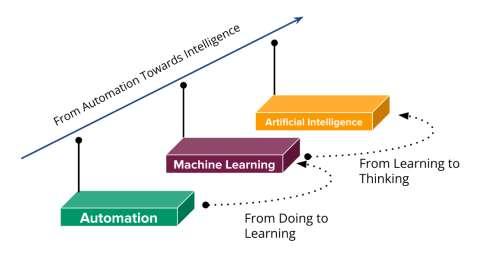
2.1.2. Following example further explains how AI is the future of automation. Operations of call centres with sharing loads between agents and automated Interactive Voice Response System (IVRS) have improved accessibility, efficiency and capacity of call centres, in terms of volume of calls being handled and reduced response time to customers’ queries.
If the same automated system is enabled with AI, it addresses the concerns of customers by learning from past experiences. Further, the
system can be operated on 24*7 basis with enhanced capability and ability to think after learning. The AI provides cognitive ability to think and therefore helps in addressing complex issues with improved customer satisfactions.
2.1.3. The idea behind AI is to create machines which emulate human faculties of cognition, reasoning, analysis among others. A simple representation in figure 2.2 describes the concept of AI. The Virtual Assistants for example Tobi (Vodafone), Personalised Tariff Plans (Smart Recommendation Engine), Smart Cars (Google’s self-driving car project to Tesla’s “autopilot”) and Self Organising Networks are a few areas where AI is being used.
Figure 2.2: AI in a nutshell

2.1.4. Further, following paras describes the status and trends of AI18:
i. Trend of ML Algorithms: In areas of speech recognition, computer vision, Natural Language Processing (NLP), deep learning algorithms bring more practicality than the classical machine learning algorithms. More deep learning algorithms are continuously being developed by academia and industry.
ii. Trend of dataset: AI public data sets are constantly being enriched and every industry is building its own AI data set which is driving the industrial development of data as a service.
iii. Trend of Chips: Although Central Processing Unit (CPU), Graphics Processing Unit (GPU) and Field Programmable Gate Arrays (FPGAs) are mainly used in AI, Application-Specific Integrated
18https://www.itu.int/en/ITU-T/Workshops-andSeminars/201903/Documents/Jun_Liao_Presentation.pdf
Circuit (ASIC) chips for Neural Network algorithms are also being launched. Brain-like chips such as Neuromorphic chips are still at the stage of research and development.
iv. Trend of AI platforms: Open-source AI frameworks such as
Tensorflow, Pytorch, Azure etc have become the focus of AI layout for both academia and industry. Recent trend is towards developing AI capabilities and building an AI ecology.
v. Trend of AI products: Presently, AI products can cater to only a specific scenario in the field of speech, vision and motor action but intelligent products are being continuously developed to support more and more complex scenarios.
vi. Trend of businesses: Telecom operators are paying attention to scenario-driven applications in the medical industry, the financial industry, the retail industry, etc.
2.1.5. Similarly, AI also brings vast opportunities for telecom sector too. However, before leveraging AI, it is necessary to understand AI and its related terms to identify new opportunities for telecom sector. The following covers all these aspects in detail.
2.2. What is AI and how it works?
2.2.1. Over the years, there have been numerous attempts to define AI precisely. However, till date, there is no globally accepted definition of AI. Governments, regulatory agencies, international agencies, and other forums have adopted varying definitions depending on the context before them. John McCarthy19, the father of AI, who coined the term in 1956, defines it as "the science and engineering of making intelligent machines." Following are some of the definitions of AI that have been adopted in different contexts.
i. ETSI20 defines AI as “a computerised system that uses cognition to
19 http://jmc.stanford.edu/artificial-intelligence/what-is-ai/index.html 20 https://www.etsi.org/deliver/etsi_gr/ENI/001_099/004/01.01.01_60/gr_ENI004v010101p.pdf
understand information and solve problems”.
ii. ISO/IEC 2382-28 [i.7]21 defines AI as "an interdisciplinary field, usually regarded as a branch of computer science, dealing with models and systems for the performance of functions generally associated with human intelligence, such as reasoning and learning".
iii. NITI Aayog in its report22 on the National AI Strategy defines AI as a constellation of technologies that enables machines to act with higher levels of intelligence and emulate the human capabilities of sense, comprehend and act while acknowledging the largely accepted definition of AI outlined by scientists such as John
McCarthy, Alan Turing, and Marvin Minsky.
2.2.2. Globally, the solution providers and organisations categorise AI applications based on their capabilities and based on their functionalities. As per Industry practice23 AI may be divided into following types based on the capabilities as shown in Figure 2.3:
Figure 2.3: Types of AI based on capabilities
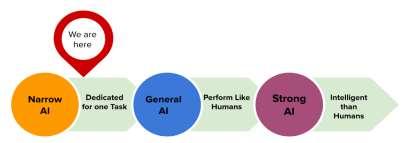
i. The Weak AI, also known as narrow AI, has limited functionality. IBM24 considers self-driving cars and virtual assistants such Siri under the category of Weak AI. Weak AI has changed many aspects of business and our personal lifestyles by being able to solve or complete tasks much quicker or better than humans can.
21 https://www.iso.org/obp/ui/#iso:std:iso-iec:2382:-28:ed-1:v1:en 22 https://niti.gov.in/writereaddata/files/document_publication/NationalStrategy-for-AI-Discussion-Paper.pdf 23 https://www.ibm.com/cloud/learn/strong-ai#toc-strong-ai--YaLcx8oG 24 https://www.ibm.com/cloud/learn/strong-ai
It has certainly been a transformative technology thus far.
ii. The General AI are those applications where machines emulate human capabilities and perform any task just like a human.
Currently, there are no such example but the research and development are focused on achieving this technology.
iii. The Strong AI at this point may only be theoretical. It’s when
machines develop consciousness and decision-making on par (or better) than humans. When strong AI is achieved, the machines won’t rely on human programming to be able to think or accomplish tasks. Additionally, machines with strong AI may be able to exhibit self-awareness and emotions. Ultimately, the goal with strong AI is a machine that has intelligence in true human form.
AI applications can also be classified based on the functionalities of AI systems. Depending on how a machine compares to humans in terms of versatility and performance, it can be a simple reactive machine that focuses only on current scenarios and reacts as per possible best action, or an intelligence exhibiting emotions capable of interacting socially like humans. The following are the types of AI-enabled machines based on their likeness to the human mind and behaviour.
i. Reactive machines: These are the simplest AI machines which can perform basic operations like object recognition, spam filter, etc. They merely react to the given input or scenarios and give output, during which no learning happens. The functionality of these machines is confined to one task only. For example, IBM chess program that beat Garry Kasparov in the 1990s.
ii. Limited Memory Machines: AI systems can use past experiences to inform future decisions. Limited memory machines have the capabilities of purely reactive machines, but is capable of learning from historical data to make decisions. For instance, an image recognition AI is trained using thousands of pictures and their
labels to teach it to name objects it scans. When an image is scanned by such an AI, it uses the training images as references to understand the contents of the image presented to it, and based on its “learning experience”, it labels new images with
increasing accuracy. Almost all present-day AI applications, from chatbots and virtual assistants to self-driving vehicles, are all driven by limited memory AI.
iii. Theory of mind AI is the AI system that can understand the entities. It interacts by discerning their needs, emotions, beliefs, and thought processes.
iv. Self-aware AI, which is self explanatorily, is an AI that has evolved to be so akin to the human brain that it has developed self-awareness. Creating this type of AI is and will always be the ultimate objective in all AI research and also a regulatory challenge.
2.2.3. How does AI Work?
i. Traditional programming methodology compelled programmers to use their own intelligence to write algorithms and create programs.
These programs were then fed with data to generate desired outputs.
However, recent advancements in technologies like AI enable machines to write their own programs with given data and desired outcomes. The figure 2.4 shows how AI is different from traditional programming.
Figure 2.4: Comparison between traditional programming and AI
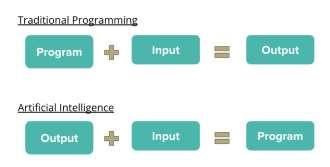
ii. The following paras describe the working of AI and the learning process of AI. To better understand the working of AI, a flowchart is shown in figure 2.5. The process of data handling in AI, is as follows:
The historical data is divided into three parts: training data, validation data and testing data. The working of AI begins with model training. The model is trained on training data for a given set of parameters at this stage. This process produces a trained model and training evaluation data. The next step is to validate the model based on validation data. This stage also produces validation data results.
Thereafter, validation data results are fed into parameter tuning to achieve the desired objective. The process continues till a final model for the desired objective is produced. At last, the final model is launched in the system to work upon the testing data.
Figure 2.5: Flowchart of various stages in AI modelling
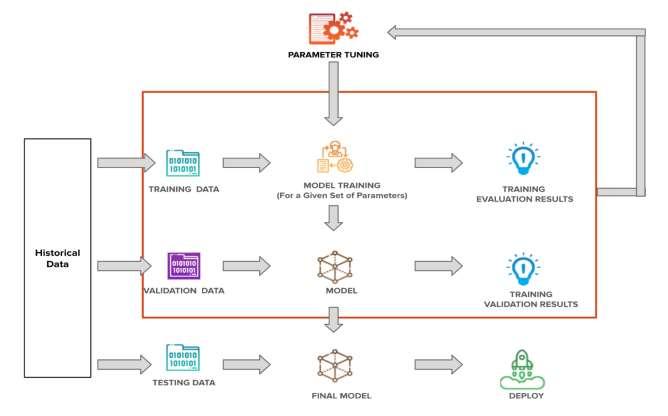
iii. In the above discussion, the training phase includes learning from data which makes the machines capable of understanding underlying hidden patterns in data. This learning process is termed Machine
Learning. Machine learning25 is defined by ITU as, “a process that enables computational systems to understand data and gain knowledge from it without necessarily being explicitly programmed”. To gain knowledge, one can understand the process by considering the following modelling techniques used in machine learning:
a. In Supervised Learning, labelled data is used for training. Since the data is known, the learning is, therefore, supervised, i.e. directed into successful execution. The input data goes through the Machine Learning algorithm and is used to train the model.
Once the model is trained based on the known data, one can use unknown data into the model and get a new response. Consider this use case where an autonomous car is employing a supervised learning model which has been trained to recognise various objects on the road, such as, pavement, humans, traffic lights, roads, sideways, cars, buildings etc. The car navigates effortlessly on the road, avoiding collisions. This is achieved through innumerable nuances of each object being used to train the ML model. Understanding the hidden characteristics of each object, the machine learns to identify and distinguish among them.
b. Unsupervised Learning, also known as unsupervised machine learning, refers to the use of artificial intelligence (AI) algorithms to identify patterns in data sets containing data points that are neither classified nor labelled. These algorithms discover hidden patterns or data groupings without the need for human intervention. Its ability to discover similarities and differences in information make it the ideal solution for exploratory data analysis, cross-selling strategies, customer segmentation, and image recognition.
c. Reinforcement Learning is another method where the requirement of supervisor or labelled data is not required, rather
25 https://www.itu.int/rec/dologin_pub.asp?lang=e&id=T-REC-Y.3172-201906-I!!PDF-E&type=items
training happens in the form of interaction with the environment and observing its response. This method is similar to how a dog learns to fetch a wooden stick. Dogs are rewarded with a biscuit on successful completion of tasks but may not get one when doing otherwise.
iv. The figure 2.6 given below highlights what types of ML techniques may be used in which type of applications in telecom:
Figure 2.6: Machine Learning Classifications26
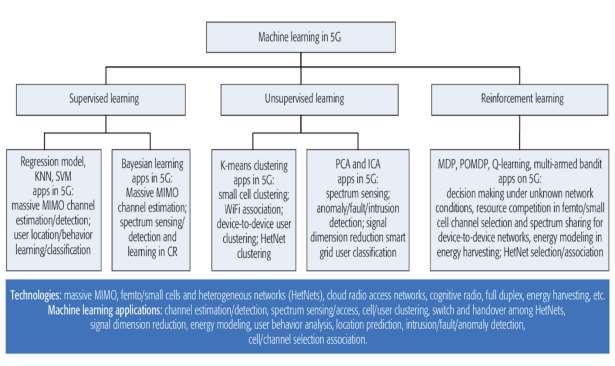
v. The above discussion emphasises that AI models utilise large datasets to train, evaluate, and optimise the models. Data plays a key role in developing an AI model. However, the following question may arise while leveraging this data for developing AI/ML models.
a. Who will provide such datasets? b. Who will validate the data?
c. Who will test the models?
d. How is such data being collected or generated? e. Can such datasets be shared with others?
26 https://www.guavus.com/wp-content/uploads/2018/10/AI-in-TelecomOperations_Opportunities_Obstacles-2.pdf
f. Does it require consent of the users? g. How does it ensure privacy?
vi. There are many such questions which are required to be answered before developing any AI model. Further, with emergence of big data in analysis and visualisation of extensive datasets with heterogeneous characteristics give rise to variety of such questions such as what is big data, how traditional data is different from big data and many more. All such questions are required to be answered before leveraging these technologies in telecom sector. Thus, to answer all such questions, it is necessary to understand big data and its related terms which are discussed in detail in following sections.
2.3. Big Data (BD): Definition, Fundamentals, Topology and Role in
Decision Making
The evolution from automation to AI is inherently connected with the proliferation and use of huge quantum of data which is popularly known as Big Data (BD). The following sections describe what BD is and how big data plays a key role in supporting decision making which further contributes to AI. Also, the sections cover factors that accelerate the growth of AI, risks associated with AI among others.
2.3.1. What is BD?
BD generally refers to technological developments related to data collection, storage, analysis and applications. The International Telecommunication Union (ITU) defines BD as “a paradigm for enabling the collection, storage, management, analysis and visualisation, potentially under real-time constraints, of extensive datasets with heterogeneous characteristics”.
2.3.2. How BD is different from traditional data?
Traditionally, data was stored in well-defined structured format which made it easy to store and access for further processing. The traditional data includes household surveys, institutional records or censuses, 20
complaint records, etc. The sources of traditional data include Enterprise Resource Planning (ERP) transaction data, Customer Relationship Management (CRM) transaction data, financial data, organisational data, web transaction data etc. It was stored locally as well as centralised, and accessed by using tools like Structured Query Language (SQL). However, with advancements in technologies, a network consists of millions of connected devices, each device generating large amount of data in different formats. It becomes difficult for traditional tools to access and process such heterogeneous large volumes of data. Today, the source of data may be any point, from an actuator to smartphones including social media, device data, sensor data, video, images, audio etc. The complex data so generated is present and distributed across the globe. Thus, with increase in complexity in handling large volume of data, advanced tools such as Hadoop, Spark were developed and now they have become popular for accessing and processing data.
2.3.3. Fundamentals of BD
Most of the organisations and companies stated that BD is characterised by the volume, velocity and variety of data being produced (“the three
Vs”). However, as per report27 published by ITU, BD is characterised by the 4 “Vs”: Volume, Velocity, Veracity and Variety. Variety refers to structured, unstructured and semi-structured data that are gathered from multiple sources. Veracity refers to the biases, noise and abnormality in data. Velocity refers to both how fast data is being collected and how fast data is processed by big data technologies to deliver the expected results. Volume refers to the large volumes of data that are generated on a daily basis from various sources. The report mentioned social media, call detail records, sensors, web scraping and satellite imagery are just a few new sources of data. A few forms of Big Data are shown in figure 2.7:
27 https://www.itu.int/dms_pub/itu-d/opb/tnd/D-TND-02-2021-PDF-E.pdf
Figure 2.7: Forms of big data
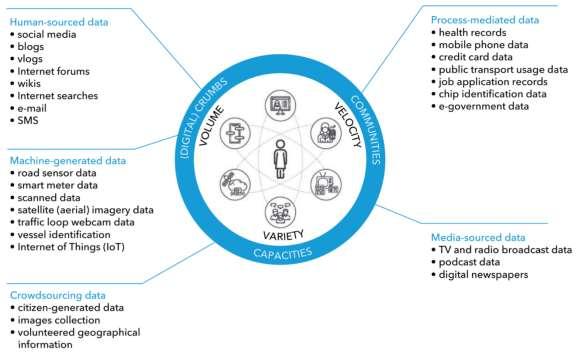
2.3.4. BD Topology
i. ITU in its report28 categorises data in three categories which are discussed below:
a. Structured data: The data often stored in databases, used mostly in programming and computer-related activities come under structured data which can be generated either by human or machines. The data which human feeds into a computer for example name and other personal details are considered as humans generated structured data whereas all data received from sensors, weblogs, financial systems, medical device data,
GPS data and usage-statistic data captured by servers and applications are considered as machine-generated structured data.
b. Semi-structured data: The dataset which do not conform to
the formal structure of data models and contain tags or
28 https://www.itu.int/dms_pub/itu-d/opb/tnd/D-TND-02-2021-PDF-E.pdf
markers to identify the such data come under semi-structured data. For example, photos and videos may contain tags related to the location, date, or by whom they were taken, but the information within has no structure.
c. Unstructured data: The dataset which do not have a predefined data model and are not organised in any defined manner come under unstructured data. Satellite imagery data, scientific data from various experiments and radar data captured by various technologies, social media data, mobile data and website content found on the Internet fall in the
category of unstructured data.
ii. ITU also highlighted another classification of big data that reflects whether the data have been produced intentionally or unintentionally and whether they were generated by human or machines. Following types of big data are worth mentioning:
a. Metadata (data about data): This term is used to classify, categorise, and retrieve data files. Metadata facilitates data analysis by assigning attributes (e.g., date of data creation, number of pages, data size and keywords) to existing data. For example, each book has a number of standard metadata on the covers and inside. This includes a title, author name, publisher and copyright details, description on a back, table of contents, index, and page numbers etc.
b. Data exhaust: This type of data is unintentionally created by humans and generally has low value. It is basically the trail left by millions of users, which can, however, be mined to extract value. For instance, Call Detail Records (CDR) metadata derived from mobile phones or data trails left by users engaged in other activities, such as keystrokes (e.g., from a log file or cookies) fall under data exhaust.
c. Human-sourced (citizen-generated) data: This type of data is
intentionally created by humans through their social media presence, videos, academic papers, and blogs, which can be mined. By compiling, combining and anonymizing thousands or more of these types of data, popular or emerging trends can be analysed.
d. AI-sourced data: These data are also intentionally created, though by AI rather than humans. For instance, secondary data can be created by chatbots assisting users with filling out online forms.
e. Personal data: An information that relates to an identified or
identifiable individual.
f. Non-personal data (NPD): Data that either never related to an identified or identifiable natural person or have been sourced from personal data excluding any personal identifier, i.e. data which were initially personal but have since been aggregated and/or anonymized.
g. Open data: Publicly available data that can be universally and readily accessed, used, and redistributed free of charge.
2.3.5. Big Data Analytics
Big data analytics involve a number of steps that are crucial in obtaining relevant insights. These steps and processes are represented in an architectural framework that supports analytics in an organised manner. Before analytics begin, the data must be collected from both internal and external sources. Authenticity and quality of data plays an intrinsic role in determining the value of insights. The framework of Big Data Analytics involves following processes:
i. Data Collection: The gathered data is present in raw form collected from heterogeneous sources which exhibits a variety of data structures. There are two kinds of sources, internal sources which includes operating systems, business systems etc. and the external
sources that include market research agencies, complaints etc. For processing, data should be collected in matrix form having high dimensionality.
ii. Data Pre-processing and Analysis: The gathered data contains redundancy, inconsistency, and useless information. This semi structured and unstructured data cannot be directly stored in relational databases (with neat tables of rows and columns). To avoid unnecessary storage space, and ensure the processing efficiency, the data should be pre-processed using techniques like integration, cleaning, redundancy elimination etc. to be ready for data analysis, before it is transmitted to the storage systems.
iii. Big Data Analytics platforms and tools: After ensuring the quality and removing inconsistencies, data can be fed to analytics tools such as Apache Spark, Hadoop etc. which are open-source software frameworks for distributed storage and distributed processing of large-scale datasets. Hadoop is a software framework for distributed storage and distributed processing of large sets of data. Similarly,
Apache Spark is a platform for large scale data processing that is well suited for iterative machine learning tasks.
2.3.6. BD Supporting Decision Making: Predictions, Algorithms and AI
With the increased availability and use of data, decisions are increasingly being facilitated or sometimes even completely taken over by using predictive modelling methods, often referred to as the use of algorithms. Using data to predict incidents or behaviour is a major part of developments related to AI. Using AI for BD is a logical step for companies looking to maximise the potential of big data. AI systems use data-driven algorithms and statistical models to analyse and find patterns in data. This is different from traditional rules-based approaches that follow explicit instructions. Big data provides raw material by which AI systems can derive insights. Many organisations are now realising the benefit of combining big data and AI. Following are the examples of how adoption of AI for BD benefits the organisations.
i. Netflix uses ML algorithms for better understanding the users, and providing more personalised recommendations. This keeps the user on their platform for longer period and creates an overall positive customer experience.
ii. Google uses ML to provide users with a highly valuable and personalised experience. They are using ML in a variety of products including providing predictive text in emails and optimised directions for users looking to get to a designated location.
iii. Starbucks is using big data, AI to provide personalised emails using data from customers' past purchases. Rather than crafting only a few dozen emails on a monthly basis with offers for the broad Starbucks audience, Starbucks is using its "digital flywheel" with AI-enabled capabilities to generate over 400,000 personalised weekly emails featuring different promotions and offers.
iv. Topic Data29 is a Facebook technology that displays to marketers the responses of the audience about brands, events, activities, and subjects in a way that keeps their personal information private.
Marketers use the information from topic data to selectively change the way they market on the platform as well as other channels. With
Topic Data, Facebook has grouped the data and stripped personal information for user activity to help marketers by offering insights on all the possible activities related to a specific topic. This gives marketers an actionable and comprehensive view of their audience, which can be further improved by adoption of AI.
2.3.7. The discussion so far emphasises on how BD plays a key role in decision making for AI models. Big data contributes in analysing and visualisation of extensive datasets with heterogeneous characteristics. It also helps AI in predictions from the available datasets and utilising those predictions for improving the services. With the support of BD analytics, AI systems can learn, think and perform tasks by using past
29 https://www.simplilearn.com/how-facebook-is-using-big-data-article
knowledge and learnings acquired through various scenarios. For example, the predictions from the information of traffic flow for an area help in providing customised services or personalised services to the customers of that area. The telecom sector also generates vast amount of such data at each and every node which is discussed below. This data along with AI may open up play new opportunities for telecom sector.
2.3.8. BD in Telecom
i. Telecommunications industry generates and stores tremendous amount of data. These include call detail data, which describes the calls that traverse the telecommunication networks; network data, which describes the state of the hardware and software components in the network and customer data, which describes the telecommunication customers. Globally, average usage per smartphone now exceeds 10GB per month, and is forecasted to reach 35GB by the end of 2026. It is also forecasted that in 2026, 5G networks will carry more than half of the world’s smartphone traffic.
ii. With the increasing adoption of smartphones and growth in mobile internet, telecom service providers today have access to exceptional amounts of data sources including customer profiles, device data, call detail records, network data, customer usage patterns, location data, data combined together may become the Big Data, which was discussed in the previous section.
Table 2.1: Big Data in Telecom30
Network Infrastructure Product Marketing & Sales Customer Care Billing
●Network Events
●Call records (on and off network)
●Number of text and multimedia ● Product catalogue
●Product life-cycle data
●Product and ● Customer Devices
●Option preferences
●Sales channel data ● Order data
●Contact data
●Fault handling data ● Call duration records
●Traffic data
●Usage history
30 https://www.tatatelebusiness.com/whitepapers/big-data-and-the-telecom-industry/
messages
●Volume of data traffic
●Location-specific data
●User handset data
●Technical fault data platform costs
●Innovation roadmap
●Product usage
●Critical Products
●Product delivery management ● ARPU classification
●Response rate of marketing campaigns
●Segmentation data
●Usage patterns
●Subsidy levels ○ Problem type
○Resolution time and rates
○Repeated faults
●Call centre logs ● Customer account data
iii. Following are some case studies of Big Data Analytics in mobile cellular networks:
a. Big Signalling Data31: In mobile cellular networks, the transmission of voice and data is accompanied by control messages, which are termed as signalling. The signalling works according to the predefined protocols and ensures the communication’s security, reliability, regularity and efficiency. Signalling monitoring plays an important role in appropriate allocation of network resources, improving the quality of network services and real-time identifying network problems, and many more. With the rapid development in various mobile cellular networks, the volume of signalling data grows tremendously and the traditional signalling monitoring systems may be not having requisite capabilities to handle such voluminous data. Figure 2.8 describe signalling data monitoring and analysing system architecture with big data analytics. This architecture mainly consists of three components: data collection, data analysis and applications. In data collection, various signalling protocols are copied from multiple network interfaces without interrupting normal operations. Afterwards, these copies are gathered and filtered through the protocol processor and then sent to the analyser.
31 https://ieeexplore.ieee.org/document/7429688
In the analyser, the data is processed using various algorithms, such as decomposition and correlation analysis. Finally, the analysis results can be used by various applications.
Figure 2.8: The Big Signalling Data in Cellular Networks
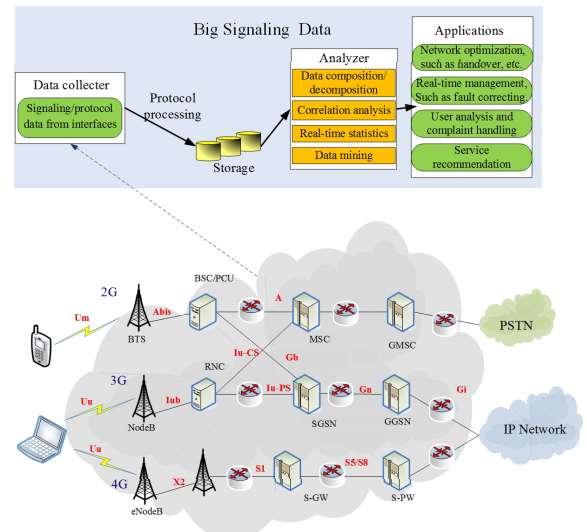
b. Big Location Data32: Human activities are based on locations, and analysis of location data is informative. As illustrated in Figure 2.9, the location based big data is generated by GPS sensors, WiFi, and Bluetooth through mobile devices. These datasets can be helpful in planning, transportation, constructions, understanding demographic trends, and many more. It can also gain amazing business insights, such as mobile advertising and marketing. An end-to-end Hadoopbased system was developed with a number of functional algorithms operated on Call Detail Records (CDRs). By analysing information about subscribers’ habits and interests,
32 https://ieeexplore.ieee.org/document/7429688
the systems is capable of providing valuable information about when, where and how the individuals (e.g., sports fans, music lovers, etc.) move.
Figure 2.9: Big Location Data in Mobile Cellular Networks
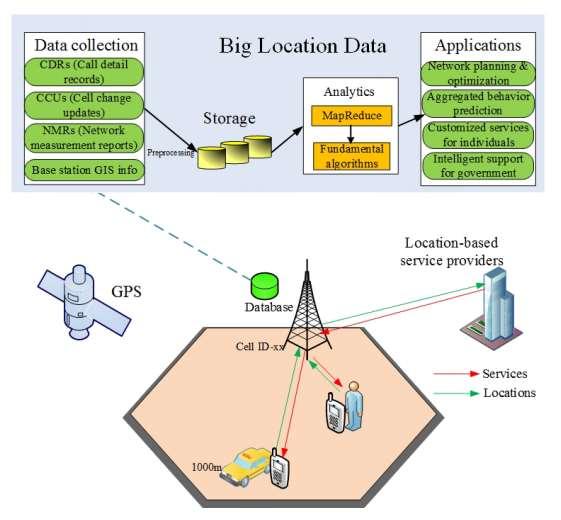
c. Network Management33: The current Network Management
Interface (NMI) model is being challenged as society enters in a new era where enormous amounts of Big Data is available at a comparatively very low cost. The recent advancements in data analytics enable a case for un-instrumenting Network
Equipments (NEs) by relieving them of supporting any protocols. Application of AI/ML, big data and data lakes with very fast data transfer rates will free NEs from the unnecessary additional burden of instrumenting NMIs protocols. It will provide for more efficient utilization of NE resources to focus on its core functions with significant improvements in performance of packet processing rate to achieve the desired low latency requirements of a 5G network.
33 https://www.5gamericas.org/wp-content/uploads/2019/11/Management-Orchestration-andAutomation_clean.pdf
2.4. Technological Advancements: Catalyst for the Growth of AI
The intelligence of AI depends on the various elements i.e. data, algorithm, model, etc. Artificial Intelligence operates via means of processing data through algorithms. It combines massive data units with its algorithms, gaining knowledge from that data. Following are the key factors that accelerate the growth of AI:
2.4.1. The explosion of data availability through connected devices
As discussed in para 2.2.3, the data acts as fuel in the learning, training, and validation phase of the modelling in the AI. Also, it is a known fact that “the greater the number of features in AI operations, the greater the amount of data needed” and “greater is the number of devices, the greater amount of data will be generated”. The Internet of Things (IoT) is finding its way across various industries and applications, and the data generated from these devices is creating new opportunities to improve business outcomes. IDC34 predicts that by 2025 there will be 55.7 billion connected devices worldwide, 75% of which will be connected to an IoT platform. IDC estimates data generated from connected IoT devices to be 73.1 Zeta Byte by 2025, growing from 18.3 Zeta Byte in 2019. Thus, the rise of connected devices has created an explosion of the availability of data which will accelerate the adoption of AI.
2.4.2. Advancement in AI Computing Infrastructure
i. As technology advances, the hardware used in computing is upgraded to meet the demands. The present trend of usage of the computing Infrastructure has changed a lot in the last two decades. Initially, the focus was more on the processing of scalar data by using a CPU based system with single or multi-core processors. Later, CPUs were followed by Graphics Processing Units (GPUs). A GPU’s speed and efficiency are much faster than the CPU. It renders images and
34 https://informationmatters.net/internet-of-thingsstatistics/#:~:text=Summary%3A%20%E2%80%9CIDC%20predicts%20that%20by,from%2018.3%20ZB% 20in%202019.
graphics quickly. A GPU can perform tasks in a parallel way as it consists of thousands of cores. GPU uses these cores and has the
capacity to perform multiple tasks as per cycle.
ii. Tensor Processing Unit (TPU) is the most advanced form of a processing unit. It is used on a commercial basis (in supercomputers and heavy machines). These are specially designed for machine learning and artificial intelligence software. Initially, it was developed by Google in 2017. With the help of TPUs, Google enhanced its machine learning mechanism and neural networks. TPU is much faster and works efficiently. They are designed to do some single tasks in supercomputers.
iii. Medium35 highlights that the differences between CPU, GPU and TPU are based on the ability to perform several operations as per cycle. The smallest unit of data handled at a time in CPU is a Scalar which
is 1x1 dimensional data. On the other hand, GPUs can perform tens of thousands of operations at a single time. It is much faster and more reliable than the CPU. Because the dimension of data is generally 1 x N data unit per cycle. CPUs are best at handling single, more complex calculations sequentially, while GPUs are better at handling multiple but simpler calculations in parallel. But the problem of memory access is still there. Because GPU performs parallel computation on thousands of Arithmetic Logic Units (ALUs), so it also spends more energy on memory access. To overcome this problem Google designed TPU. TPU is the most complex chip for computers. It can manage Thousands of thousand operations in one cycle. Its performance and speed are much higher than the other both. This is because it can operate N X N data units in one cycle. Also, TPU solved the memory access problem. The computation difference between them is shown in figure 2.10.
35 https://medium.com/analytics-vidhya/cpu-gpu-tpu-ml-perspective-1f049cd4d43d
Figure 2.10: Computation difference between CPU, GPU and TPU
2.4.3. Adoption of AI-Specific Hardware and Chips

i. Until recently, almost all AI computations were being performed remotely at respective data centers, on enterprise core appliances, or on telecom edge processors and not locally on devices. This is because
AI computations are extremely processor-intensive, requiring hundreds of (traditional) chips of varying types to execute. The hardware size, cost, and power drain made it essentially impossible to house AI computing arrays in anything smaller than a footlocker.
Now, edge AI chips are changing all that. They are physically smaller, relatively inexpensive, use much less power, and generate much less heat, making it possible to integrate them into handheld devices such as smartphones as well as non-consumer devices such as robots. By enabling these devices to perform processor-intensive AI computations locally, edge AI chips reduce or eliminate the need to send large amounts of data to a remote location thereby delivering benefits in usability, speed, data security and privacy.
ii. Further, not all AI computations have to take place locally. For some applications, sending data to be processed by a remote AI array may be adequate or even preferred. For instance, when there is huge volume of data for a device’s edge AI chip to handle, remote processing may be preferred. In fact, most of the times, AI will be done in a hybrid fashion: some portion on the device, and some in the cloud. The preferred mix in any given situation will vary depending on exactly what kind of AI processing needs to be done.
iii. Deloitte forecasted36 that the adoption of edge AI chips by devices will grow from 750 million devices in 2020 to 1600 million devices in 2024. Smartphones are not the only devices that use edge AI chips; other device categories like tablets, wearables, smart speakers, contain them as well. The forecast figures are shown in the figure 2.11.
Figure 2.11: The Edge AI chip growth

iv. Currently, only the expensive smartphones are likely to use edge AI chips. The term “AI chip,” refers to the portion of the overall silicon
die that is dedicated to performing or accelerating machine learning calculations. The following are some example of AI chips:
a. Kirin 980 by Huawei, an artificially intelligent chip enables higher intelligence to phones, unparalleled battery life, powerful camera, and more.
b. Exynos 9820 by Samsung, flaunts a dedicated Neural Processing
Unit (NPU) to handle smartphones AI functions like Image recognition, translation, speech transcription on the device itself with greater efficiency.
c. A12 Bionic by Apple, features a graphics processing unit and a Neural Engine which powers an artificial intelligence accelerator.
d. An AI chip named ‘SAPEON X220’, by SK Telecom (SKT),
optimally designed to process artificial intelligence tasks faster, using less power by efficiently processing large amounts of data
36 https://www2.deloitte.com/us/en/insights/industry/technology/technology-media-and-telecompredictions/2020/ai-chips.html
in parallel.
v. The recent development of a new kind of computing architecture similar to the processing of information by a biological brain is known as neuromorphic computing. One of the most promising forms of neuromorphic computing uses “spiking neural networks” to emulate
the way a biological neuron fires (or “spikes”) to transmit a signal before returning to a silent state.
2.4.4. Shift from Clustered (Centralised) Computing Processes to Cloud
and Edge (Distributed) Computing Processes
i. The computing technology has evolved from centralised mainframe computing to edge computing where computing occurs at edge devices installed near to the users. This evolution involves several
other stages as shown in the figure 2.12.
Figure 2.12: Trend of computing technologies
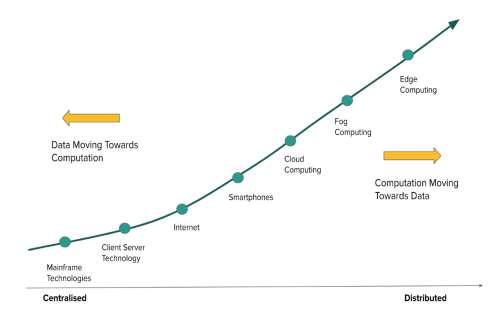
ii. Earlier, data was transferred from devices to the mainframe for computation, and now the data remains within the device and the computation occurs at the edge. As discussed above, various AI chips are being manufactured for the purpose of edge computing to solve the issues of privacy and reduce the latency by performing
computation at the edge.
2.4.5. Recent developments in learning models
From being the area of computer science, AI has clearly moved on, adding the understanding of psychology, neuroscience etc. Synonymous with the word AI, words like deep learning, neural network have become quite popular. The figure 2.13 depicts the journey and relations between them.
i. Deep Learning: Deep learning is a class of machine learning algorithms inspired by the structure of a human brain. In a neural network, the information is transferred from one layer to another over connecting channels. They are called weighted channels because each of them has a value attached to it. Deep learning models have exceeded expectations in terms of performance and arriving at the state-of-the-art results.
Figure 2.13: Evolution of AI
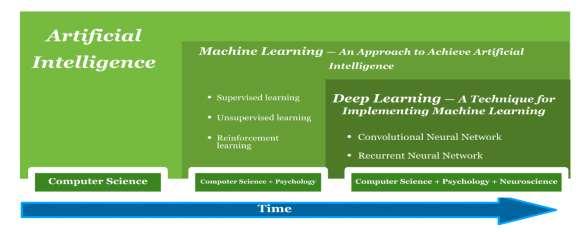
ii. Artificial Neural Networks (ANN): Inspired by the human brain and its functioning, a network of artificial neurons is connected which mimics the neurons in the human brain. Training the network using a nuanced dataset establishes weighted connections which eventually activates certain neurons upon receiving certain input. For instance, the fragrance of a flower activates certain neurons in the human brain which is distinctly different from that
in the case of a burning wooden log. Similarly, perceptrons (artificial neurons) are trained by an extensively large dataset.
iii. Convolutional Neural Networks (CNNs): Connections between neural networks are inspired by the organisation of the animal visual cortex (Portion of the brain that processes images) wellsuited for perceptual tasks.
iv. Graph Neural Networks (GNN): Recently another neural network known as Graph Neural Networks (GNN) received a lot of attention. GNNs have the ability to understand graph structured data. GNN extends the existing neural network for processing the data represented in graphs. In GNN, the idea of “time step” or
“sequence” becomes flexible. Producing a sequence of outputs can
be thought of as walking the graph, with each step predicting the next node, based on the graph’s structure and a history of nodes
visited. ITU has recently launched ITU AI/ML in 5G Challenge: Graph Neural Networking Challenge 2020. This competition has invited innovators worldwide to develop Artificial Intelligence /Machine Learning (AI/ML) solutions for 5G networks.
v. Generative Adversarial Networks (GANs): GANs are major breakthrough, endowing deep networks with the ability to produce artificial content such as fake images that pass for the real thing. GANs consist of two interlocked components, a generator, responsible for creating realistic content, and a discriminator, tasked with distinguishing the output of the generator from naturally occurring content. The two learn from each other, becoming better and better at their respective tasks over time. Two Neural Networks contesting one other in a zero-sum game framework (thus “Adversarial”). It can learn to mimic various
distributions of data (e.g. text, data, speech, and images). It is valuable in generating test data sets when these are not readily available.
In the past decade, machine learning technologies have moved from the 37
academic realm into the real world in multitude of ways which are both promising and cause of concern.
2.4.6. 5G Plus AI: Connected Intelligent Edge
The AI and 5G will be the key components that fuel the future innovations. These technologies when combined together will work synergistically. This means AI advancement will work towards improving 5G systems performance and efficiency while expansion of 5G will drive distributed intelligence through connected devices. Further 5G will generate massive amounts of data from multitude of new services, and billions of IoT devices, which will enhance AI learning and model training. This synergy between AI and 5G is discussed in detail in following section:
i. AI for 5G
With the increase in interconnected devices, the traffic and demands of the network will increase constantly. Heterogeneity is expected to characterize the increase in connected wireless devices and mixed usage of cells of diverse sizes and access points with different multi-radio technologies. The industry and academia are embracing 5G as the future network capable of supporting next generation vertical applications with different service requirements. To realise this vision in 5G network, physical network has to be sliced into multiple isolated logical networks of varying sizes and structures, dedicated to different types of services based on their requirements and characteristics. With all these, the network would be characterised by increased traffic, various mobility levels and interference. In addition to this, multiple requirements such as Quality of Experience (QoE), resource efficiency, energy-efficient operation and cost efficiency need to be taken into account. To manage all these requirements in real time, there is a need for enhanced intelligent systems with programmable capabilities. The softwarization of network using Software-Defined Networking (SDN) and Network Function Virtualization (NFV) in 5G networks is expected to fill the void of programmable control and management of network resources. 38
Further, as per a report by 5G Americas37 , Telemetry data analyticsbased statistics from Network Data Analytics Function (NWDAF) and RAN Data Analytics Function (RAN-DAF), combined with AI/ML, will allow operators to dynamically optimize their networks and automate 5G network slicing management.
The integration of AI with softwarization of network will make the network more flexible and agile by programming the network intelligently. The AI enables faster decision making by gathering and processing network data in real time and automating network functions, so service providers can switch from reactive to proactive mode. In selfhealing networks, AI systems are trained to look for patterns, detect, predict and localize network issues, and take proactive steps to fix the service before customers are impacted. This also has the benefit of freeing up IT professionals’ time that would otherwise be spent on
troubleshooting and repetitive tasks, letting them focus instead on strategic initiatives. As a result, AI will be able to support truly dynamic networks and services, accurately reflecting the prevailing state of the network with an up-to-date view of physical and virtual resources, while at the same time providing a complete historical record of the network to support cross-domain hybrid service orchestration and assurance.
ii. 5G for AI
While AI is supporting the effective management of 5G network and its services, there is a complementary role of 5G to drive rapid developments in AI. The high bandwidth, massive connectivity, and low latency capabilities of 5G will drive the development of IoT services by connecting massive devices. These interconnected devices will generate large amount of data to be used for training and modelling AI. Further, the low latency and high capacity of 5G will also allow AI processing to be distributed among the device, edge cloud, and central cloud, enabling flexible system solutions for a variety of new and enhanced experiences.
37 https://www.5gamericas.org/wp-content/uploads/2022/01/Cellular-Communications-in-a-5G-EraInDesign.pdf
The on-device (networked devices) training has following important benefits that will lead to mass adoption of AI:
a. Scale: Connecting massive devices can harness a significant amount of computational power by distributing processing over many devices, such as millions of smartphones.
b. Personalization: The AI model learning is inherently customised with data used for on-device training.
c. Privacy: Extracting the value of the data and preserving privacy is possible by training on devices.
d. Speed: On device training would overcome the potential issue of transfer of data such as data transmission delay or loss, which would result in inconsistent service performance, thus on device training improves speed and precision.
e. Real Time: Real-time processing is a fundamental advantage of on-device training. It supports delay-sensitive applications and services such as remote surgery, tactile internet, unmanned vehicles, and vehicle accident prevention.
The AI-powered 5G networks will accelerate the fourth industrial revolution and create unprecedented opportunities in business and society.
2.4.7. AI/ML for 6G: The 6G is expected to blur the boundaries between digital and physical realities by infusing immersive experience of augmented and virtual realities in every vertical. Intelligent knowledge systems combined with ubiquitous computation will make humans more efficient and redefine their lifestyle, conduct and work environment.
i. 6G is empowered by emerging technologies like AI/ML and digital twin models. The intelligence to learn from data and apply it in the real world is achieved through AI/ML whereas digital twin models are simulations which allow us to analyze 40
what's happening in the physical world, simulate possible outcomes, anticipate needs and then take productive actions.
ii. A Whitepaper on 6G38 highlights that evolution of telecom infrastructures toward 6G will consider highly distributed AI, moving the intelligence from the central cloud to edgecomputing resources. Another whitepaper on ML in 6G39 highlights that ML algorithms should be deployed and trained at different levels of the network: management layer, core, radio base stations, and in mobile devices, possibly with the assistance of the network itself (e.g. via configuration and/or device programmability). These new paradigms may drive the need for a ML-native and data-driven network architecture
implemented as network functions within the network and management domains, possibly requiring data from different sources. Meanwhile, physical-layer algorithms (e.g. link adaptation), as well as higher layer algorithms (e.g. mobility), can be optimized with the controlled and predictable deployment of ML agents. The role of ML at different layers of 6G networks is shown in figure 2.14.
iii. The era of 6G will bring following changes -
a. Emergence of man-machine interfaces to control and consume information.
b. Typing on touchscreen will gradually get replaced by gesture and voice control.
c. Devices will come embedded into clothing and even transform into skin patches.
d. Healthcare will be an important benefactor as wearables facilitate 24/7 monitoring of vital parameters and warning
38 http://jultika.oulu.fi/files/isbn9789526226774.pdf 39 http://jultika.oulu.fi/files/isbn9789526226736.pdf
us of the potential health problems.
e. Digital cash and keys may become the norm.
iv. The advanced multi-sensory telepresence that is created with very high data rates will reduce the need for travel through the introduction of multi-modal mixed reality telepresence and remote collaboration.
Figure 2.14: Role of ML ion 6G networks
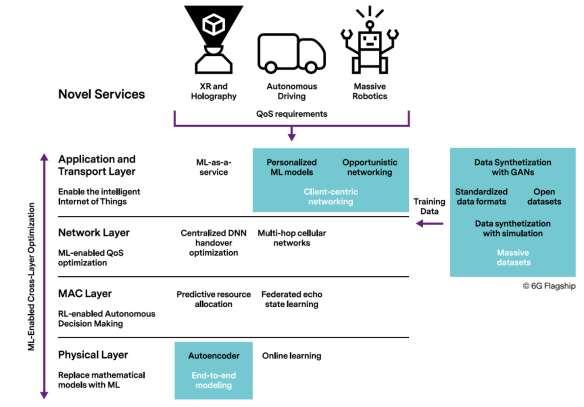
2.5. Adopting AI with caution
2.5.1. Many organisations and nations while adopting AI have started focussing on possible risks and challenges associated with it. As the emergence of AI is paving ways for new set of opportunities for everyone, it is important that its inherent risks are also considered and addressed. Risks related to data include data biases, data poisoning, and that related to models include model biases, model extraction., Further, there is a risk of privacy among users which includes data exploitation, 42
risk of identification and tracking, and individual profiling.
2.5.2. Although Artificial Intelligence is growing and gaining popularity at a rapid rate, it is important to note that AI is still facing number of challenges. Some of the common challenges that most companies face when trying to implement Artificial Intelligence, include limited AI expertise and knowledge, access to quality data, and AI specific infrastructure.
2.5.3. Considering the inherent advantages associated with AI, in order to address the challenges related to trust, new terminologies such as Trustworthy AI, Responsible AI, Explainable AI are being coined by various organisations and nations. Some use these terms to build AI systems following defined principles. Consider the initiative taken up by ITU, AI for Good40, which aims to bring forward Artificial Intelligence research that contributes towards more global problems through the Sustainable Development Goals. AI, which may be responsible for the fourth industrial revolution, should be used responsibly dealing with the larger problems of humanity as a whole.
i. Responsible AI (RAI): The impetus behind responsible AI is to design, develop and deploy AI with good intentions and to have a positive impact on society. This term “Responsible” has been used
by many, for example, google41 defined principles such as fairness, interoperability, security, and privacy. Microsoft42 put responsible AI principles into practice through the Office of Responsible AI. The notions of ethical and accountable artificial intelligence (AI) also referred to as “Responsible AI” have been adopted by many stakeholders from government, industry, civil society, and academic institutions. Making AI systems transparent, fair, secure, and inclusive should be the core elements of a responsible AI framework.
40 https://ai4good.org/ 41 https://ai.google/responsibilities/ 42 https://www.microsoft.com/en-us/ai/responsible-ai?activetab=pivot1%3aprimaryr6
However, these elements are interpreted and operationalized by each
group may vary.
ii. Explainable AI (XAI): The magic with which AI can find hidden correlations in ostensibly uncorrelated data sets, is captivating. Unlike traditional paradigms of programming, the AI model requires a rich dataset to learn and create its own logic/ rationale to produce desirable output. However, the concern of people would be understanding how the AI/ML model arrived at a particular decision/prediction/output. Explainable AI is a set of tools and framework to help understand and interpret the model’s behaviour.
To increase confidence in model and end-user’s trust, such initiatives are being taken by companies like google43, IBM44, and others. Some of the government initiatives are also active like DARPA's XAI initiatives by USA, among others.
iii. Trustworthy AI: In 2019, the EU presented Ethics Guidelines for
Trustworthy Artificial Intelligence45. According to the Guidelines, trustworthy AI should respect all laws and regulations, respect ethical principles and values, and be robust from a technical perspective while taking into account its social environment.
iv. Generative AI: AI is shifting from interpreting existing data to generating novel content at a scale. Generative AI emphasises on the capabilities of AI where it can generate or create something new for example, a new symphony, an artwork, etc, which is based on past learning experiences, Emulating the creative aspect of human beings.
v. Augmented AI: Presently, research is focused on improving the capabilities of AI technology. However, augmented AI talks about leveraging AI for enhancing/augmenting human capabilities to process/analyse huge amounts of data. This is crucial because AI is good at identifying underlying patterns in huge data, which can
43 https://cloud.google.com/explainable-ai 44 https://www.ibm.com/in-en/watson/explainable-ai 45 https://ec.europa.eu/futurium/en/ai-alliance-consultation.1.html
augment human’s capabilities. It is similar to the use of exoskeleton
technology which increases the strength and agility of humans to perform superhuman feats.
vi. Embedded AI: Devices such as smartphones, laptops, and other smart devices are being equipped with AI-enabled dedicated chips. A discussion in para 2.5 highlights the advent of AI-embedded devices.
For instance, A12 Bionic by Apple features a graphics processing unit and a Neural Engine which powers an artificial intelligence accelerator. With embedded AI, devices have the ability to run AI models at the device level and then directly use the results to perform an appropriate task or action.
2.5.4. The above discussion emphasizes that advent of AI improves the lifestyle and working environment and efficiency of businesses and individuals. The associated risks and challenges can be mitigated by bringing trust with new terminologies and processes such as Responsible AI, Explainable AI and Trustworthy AI depending upon the use cases and organisational needs. All such terminologies may be required to be generalised for future adoption in the telecom sector.



